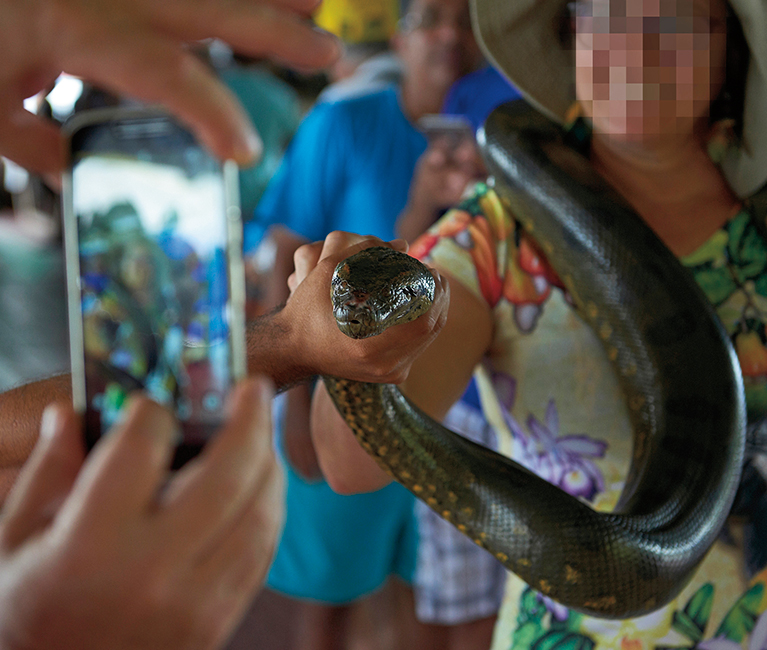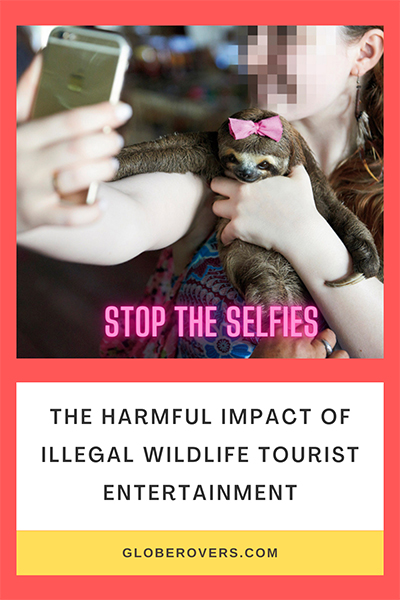
By Beth Sharpe, Toronto, Canada
Beth is the Communications Director for World Animal Protection Canada. An avid traveller, she is always looking for animal-friendly ways to see wildlife. Top trips include whale watching on two of Canada’s coasts, snorkeling in Tahiti, Belize and the Caribbean, supporting a dog vaccination clinic in the Philippines, and bird watching in Costa Rica.
Wildlife tourism, when properly managed, can be good for the environment and wild animals: it can support the protection of natural areas, improve animal welfare and alleviate poverty. But sadly, some tour operators exploit wildlife for profit in ways that lead to great cruelty and suffering.
One of the biggest culprits is the growing popularity of wildlife selfies where tourists, with the help of tour operators, capture and share images of themselves with wild animals – exploiting them as photo props.
Using a wild animal as a photo prop in a wildlife selfie can inflict stress and suffering on the animal, robbing them of their freedom and encouraging contact with humans that makes their chances of survival back in the wild much harder.
The harmful impact of illegal wildlife tourist entertainment
Behind the scenes, these animals are often beaten into submission, taken from their mothers as babies and secretly kept in filthy, cramped conditions or repeatedly baited with food that can have a long-term negative impact on their biology and behaviour.
All too often, to the unsuspecting tourist, the cruelty that makes these animals submissive and available is entirely invisible. A new ground-breaking report from World Animal Protection charts the rapidly increasing trend of selfies with wild animals on Instagram. It also unveils concerns regarding the commercial exploitation and abuse of wild animals across the Latin America region – with an investigatory focus on the Amazon and its iconic wildlife.

Wildlife and the selfie phenomenon
World Animal Protection commissioned cutting-edge ‘social listening’ research to gain stronger insights into the growing worldwide trend on social media for wildlife selfies. Using image recognition software, they analyzed the prevalence of both good and bad wildlife selfies across popular social media platforms – Facebook, Twitter and with an in-depth look into Instagram, one of the largest platforms for this social selfie phenomenon.
Through this social listening they discovered:
• 292% increase in the number of wildlife selfies posted on Instagram between 2014 to present
• Over 40% are ‘bad’ wildlife selfies – someone hugging, holding or inappropriately interacting with a wild animal
• Users are more likely to upload ‘good’ wildlife selfies when they have been educated or exposed to information or campaign messages about the cruelty inflicted on animals in tourist entertainment
Instagram does not currently include any animal cruelty or welfare language in their community guidelines. We believe it’s time for that to change.

Wildlife tourism in Latin America
World Animal Protection has also conducted the first comprehensive review of wildlife tourist attractions offering close encounters with wild animals across Latin America. Their research raises concerns that many operators and facilities are cruelly exploiting and injuring wildlife, and breaking animal protection laws in the process, to provide harmful wild animal selfie opportunities for tourists.
Desktop research uncovered new information about the scale of the problem in Latin America:
• 54% of the 249 attractions we found online offered direct contact, such as holding the wild animals for photos or selfies
• 35% of the attractions used food to attract the wild animals
• 11% offered the opportunity to swim with wild animals
Together we can ensure a better future for animals around the world, and help make sure wildlife tourism globally becomes, and remains, cruelty-free.
In addition to World Animal Protection’s welfare concerns, 61% of the species identified during this desktop review are classified as needing international legal protection by the Convention on the Trade of Endangered Species (CITES), and 21% of them are classified as “Threatened” by the International Union for the Conservation of Nature (IUCN). All this highlights that there are also concerning conservation implications for these types of wildlife tourist attractions in Latin America.
In public view and behind the scenes, during these investigations World Animal Protection uncovered the following evidence of cruelty being inflicted on these wild animals:
• Sloths captured from the wild, tied to trees with rope
• Birds such as Toucans with severe abscesses on their feet
• Caiman crocodiles restrained with rubber bands around their jaws
• An ocelot (a type of wild cat) kept in a small barren cage
• Green anacondas showing signs of dehydration and wounds
• A manatee held in a tiny tank in the forecourt of a local hotel
• A giant anteater, manhandled and beaten by its owner
They are particularly concerned about the use of sloths as photo props for selfies and the extreme negative impact on their welfare caused by the wildlife tourism industry. Several aspects of their biology and behaviour make sloths particularly vulnerable to these types of human interactions. There is good reason to believe that most sloths being used for tourist selfies don’t survive even six months of this treatment.
To start tackling this problem, World Animal Protection are calling on the relevant governments to enforce the law, and to ensure that travel companies and individuals who are exploiting these wild animals for commercial purposes in the Amazon abide by the existing laws.
The use of animals as photo props for wildlife selfies are an increasingly alarming source of animal welfare concern. The prevalence of these images on social media is almost certainly driving up the interest in this activity, with much of the cruelty involved kept hidden behind the scenes.
We all have the power to positively change the future for these animals.
Top tips for tourists:
Tourists should enjoy seeing wild animals in the wild or the next best place, a sanctuary or rescue centre that provides proper protection for animals that survive the cruelty of the tourism industry.
A few very simple tips for anyone travelling and wanting to know that their wildlife encounter is good for the animals:
- Sign World Animal Protection’s Wildlife Selfie Code and commit to keeping wild animals in the wild.
- If you can hug, hold or have a selfie with a wild animal, the chances are that it’s enduring ongoing cruelty. You may be approached to pay for your picture with a wild animal. Don’t do it.
- Don’t chase or capture wild animals for a selfie.
- Don’t feed or lure wild animals with food or bait so they come closer to you for a photo.
- Ask your tour operator whether they allow direct contact with wild animals. If the answer is no, the chances are they are a responsible operator.
- Report any concerns you have about the welfare of wild animals in tourist attractions via online platforms such as TripAdvisor and your social media channels – this helps to make others aware of the cruelty so they also choose wildlife experiences that are good for the animals.
Visit us at:
worldanimalprotection.ca


